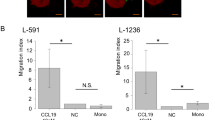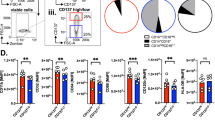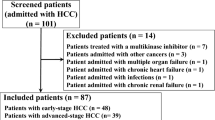Abstract
It is recently shown that PD-1 expression by immune cells of the myeloid lineage contributes to the suppression of antitumor immunity. The expression of PD-1 by antigen-presenting cells in hepatocellular carcinoma (HCC), a malignancy with high intratumoral PD-L1 expression, remained understudied. Here, we found that circulating monocytes from HBV-associated HCC patients upregulated PD-1 in a severity-dependent manner. Monocyte stimulation using IFN-γ or high levels of IL-10 could slightly increase PD-1 expression, while LPS could markedly increase PD-1 expression. Interestingly, LPS in combination with IL-4 or IL-10 presented stronger stimulation of PD-1 expression than LPS in combination with IFN-γ or LPS alone. At resting state, PD-1+ monocytes presented comparable MHC-I and IL-12 expression and higher MHC-II, CD86, iNOS, arginase I, and IL-10 expression than PD-1− monocytes. Upon LPS stimulation, PD-1+ monocytes presented lower iNOS and higher arginase I and IL-10 expression than PD-1− monocytes, indicating an M2-polarization bias in PD-1+ monocytes. CD8 T cells following coculture with PD-1+ monocytes presented lower IFN-γ and lower TNF-α expression, together with lower proliferation capacity, than CD8 T cells following coculture with PD-1− monocytes, suggesting that PD-1+ monocytes were less capable of supporting CD8 T cell activation. Overall, these data indicated that PD-1 expression was elevated in monocytes from hepatocellular carcinoma patients. In addition, PD-1+ monocytes presented a preference toward M2 polarization and had a deficiency in supporting CD8 T cells.






Similar content being viewed by others
References
Swaika A, Hammond WA, Joseph RW. Current state of anti-PD-L1 and anti-PD-1 agents in cancer therapy. Mol Immunol. 2015;67:4–17.
Riley JL. PD-1 signaling in primary T cells. Immunol Rev. 2009;229:114–25.
Makarova-Rusher OV, Medina-Echeverz J, Duffy AG, Greten TF. The yin and yang of evasion and immune activation in HCC. J Hepatol. 2015;62:1420–9.
Wang B-J, Bao J-J, Wang J-Z, Wang Y, Jiang M, Xing M-Y, et al. Immunostaining of PD-1/PD-Ls in liver tissues of patients with hepatitis and hepatocellular carcinoma. World J Gastroenterol. 2011;17:3322–9.
Gao Q, Wang XY, Qiu SJ, Yamato I, Sho M, Nakajima Y, et al. Overexpression of PD-L1 significantly associates with tumor aggressiveness and postoperative recurrence in human hepatocellular carcinoma. Clin Cancer Res. 2009;15:971–9.
Rizvi NA, Hellmann MD, Snyder A, Kvistborg P, Makarov V, Havel JJ, et al. Mutational landscape determines sensitivity to PD-1 blockade in non-small cell lung cancer. Science (80- ). 2015
Arasanz H, Gato-Cañas M, Zuazo M, Ibañez-Vea M, Breckpot K, Kochan G, et al. PD1 signal transduction pathways in T cells. Oncotarget. 2017;8:51936–45.
Xiao X, Lao X-M, Chen M-M, Liu R-X, Wei Y, Ouyang F-Z, et al. PD-1hi Identifies a Novel regulatory B-cell population in human hepatoma that promotes disease progression. Cancer Discov. 2016;6:546–59.
Chen W, Wang J, Jia L, Liu J, Tian Y. Attenuation of the programmed cell death-1 pathway increases the M1 polarization of macrophages induced by zymosan. Cell Death Dis. 2016;7:e2115.
Gordon SR, Maute RL, Dulken BW, Hutter G, George BM, McCracken MN, et al. PD-1 expression by tumour-associated macrophages inhibits phagocytosis and tumour immunity. Nature. 2017;545:495–9.
Strauss L, Mahmoud MAA, Weaver JD, Tijaro-Ovalle NM, Christofides A, Wang Q, et al. Targeted deletion of PD-1 in myeloid cells induces antitumor immunity. Sci Immunol. 2020;5:eaay1863.
Siegel R, Miller K, Jemal A. Cancer statistics, 2015. CA Cancer J Clin. 2015;65:29.
Calderaro J, Rousseau B, Amaddeo G, Mercey M, Charpy C, Costentin C, et al. Programmed death ligand 1 expression in hepatocellular carcinoma: relationship with clinical and pathological features. Hepatology. 2016;64:2038–46.
Jilkova ZM, Aspord C, Decaens T. Predictive factors for response to PD-1/PD-L1 checkpoint inhibition in the field of hepatocellular carcinoma: current status and challenges. Cancers (Basel). 2019.
Brierley JD, Gospodarowicz MK, Wittekind C. TNM classification of malignant tumours - 8th edition. Union Int. Cancer Control. 2017.
Martinez FO, Gordon S. The M1 and M2 paradigm of macrophage activation: time for reassessment. F1000Prime Rep. 2014;6:13.
Papa S, Choy PM, Bubici C. The ERK and JNK pathways in the regulation of metabolic reprogramming. Oncogene. 2019.
Karmaus PWF, Herrada AA, Guy C, Neale G, Dhungana Y, Long L, et al. Critical roles of mTORC1 signaling and metabolic reprogramming for M-CSF-mediated myelopoiesis. J Exp Med. 2017;214:2629–47.
Sica A, Allavena P, Mantovani A. Cancer related inflammation: the macrophage connection. Cancer Lett. 2008;267:204–15.
Mantovani A, Sozzani S, Locati M, Allavena P, Sica A. Macrophage polarization: tumor-associated macrophages as a paradigm for polarized M2 mononuclear phagocytes. Trends Immunol. 2002;23:549–55.
Funding
This worked was supported by the Young and Middle-aged Academic and Technical Leaders in Yunnan Province/Reserve Talent Training Program (2019), the Yunnan Health Training Project of High Level Talents (No. D-2017018), the National Natural Science Foundation of China (No. 81960514), and the Project of Kunming Medical joint (No. 2019FE001-010).
Author information
Authors and Affiliations
Corresponding authors
Ethics declarations
Conflict of interest
The authors declare that they have no conflict of interest.
Additional information
Publisher’s note
Springer Nature remains neutral with regard to jurisdictional claims in published maps and institutional affiliations.
Electronic supplementary material
Supplementary Figure 1.
Monocyte activation marker expression in PD-1+ and PD-1-monocytes following 24-hour incubation in culture medium. ANOVA followed by Tukey’s test. ns, not significant. *P < 0.05. **P < 0.01. ***P < 0.001. (PNG 201 kb)
Rights and permissions
About this article
Cite this article
Yun, J., Yu, G., Hu, P. et al. PD-1 expression is elevated in monocytes from hepatocellular carcinoma patients and contributes to CD8 T cell suppression. Immunol Res 68, 436–444 (2020). https://doi.org/10.1007/s12026-020-09155-3
Received:
Accepted:
Published:
Issue Date:
DOI: https://doi.org/10.1007/s12026-020-09155-3




